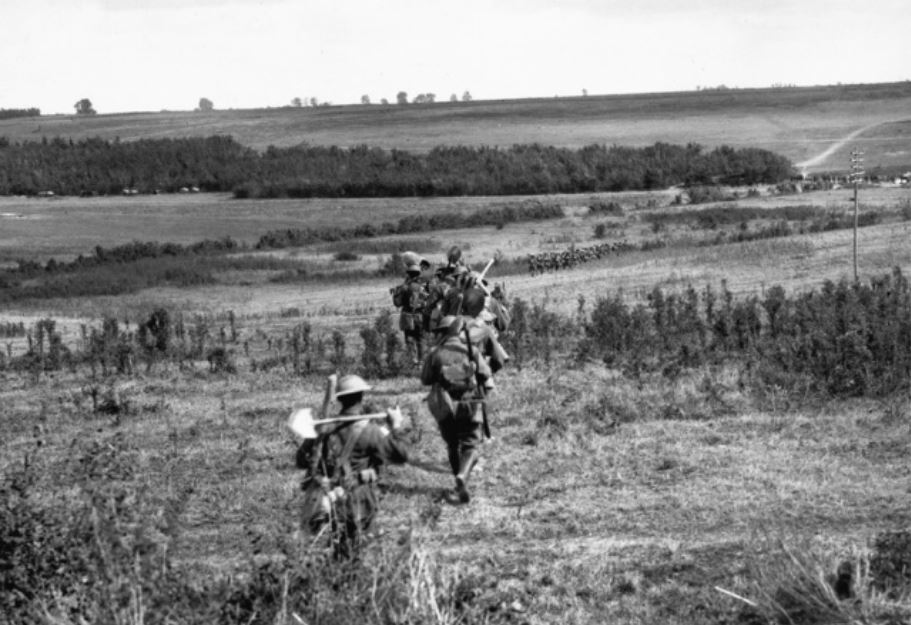Difference between revisions of "5th Pioneer Battalion"
From Our Contribution
(Created page with "{{Infobox | name = 5th Pioneer Battalion | title = 5th Pioneer Battalion | above = | subheader = | image = File:5th_Pioneer_Bat...") |
(→Battalion Personnel) |
||
| (6 intermediate revisions by the same user not shown) | |||
| Line 35: | Line 35: | ||
===Battalion Personnel=== | ===Battalion Personnel=== | ||
| − | * [[Arthur Charles Barber]] | + | * [[Arthur Charles Barber]] 30 May 1917 - 14 Apr 1919 |
| − | * [[John Feast]] | + | * [[John Feast]] - never joined the unit in the field |
| − | * [[Maurice Francis Gustavis Hare]] | + | * [[Maurice Francis Gustavis Hare]] 1 Aug 1917 - 29 Sep 1918 (WIA Hindenburg Line) |
| − | * [[Thomas Brown Mack]] | + | * [[Thomas Brown Mack]] 21 Apr - 30 Sep 1917 (WIA Polygon Wood) |
| − | * [[James Francis Ottaway]] | + | * [[James Francis Ottaway]] 7 Mar 1917 - 16 Dec 1918 |
| − | * [[George Partington]] | + | * [[George Partington]] 11 Dec 1917 - 26 Mar 1919 |
| − | * [[Francis William Wakeham]] | + | * [[Francis William Wakeham]] - never joined the unit in the field |
==Battle Honours== | ==Battle Honours== | ||
Latest revision as of 20:59, 25 February 2021
 Shoulder patch | |
 Australian 5th Pioneers around Picardie, on the Somme, September 1918 AWM photo E03317 | |
Contents
Brief History
The 5th Pioneer Battalion was established at Tel-el-Kebir on 10 Mar 1916 as part of the reshaping of the AIF, and assigned to the 5th Division. Trained as infantrymen, they were also tasked with digging trenches, labouring, constructing strong points and light railways, and undertaking battlefield clearance, the troops assigned to the pioneers required construction and engineering experience in addition to basic soldiering skills.
The 5th Pioneer Battalion was formed from volunteers from the 5th Division. Many were skilled and experienced in mining and other artisanal trades. According to some sources a majority of the battalion's recruits were from South Australia, although others refer to a significant proportion originating from Western Australia.
Training was undertaken around Mahsama and Ismailia, in Egypt, before the battalion was assigned to repair railway lines around the canal zone. In June 1916, the battalion was transported to Alexandria where they boarded HMT Canada, bound for Europe.
Their first major action came around Fromelles on 19 July 1916, where the Australians made their debut on the Western Front. Two companies of pioneers were assigned to support the attack, and it proved to be a difficult entry into the European war, with the Australians suffering such heavy casualties that the battle was later described as "the worst 24 hours in Australia's entire history.
Later, the battalion took part in the pursuit of German forces as they withdrew towards the Hindenburg Line in early 1917, working to extend the 5th Division's supply railway from Ginchy to Bealencourt in March, and then in April they extended the line around Fremicourt towards Vaulx–Vraucourt, providing the means for the Allies to bring up guns and ammunition with which to lay down a heavy bombardment on the Hindenburg Line.
Their next major action came around Ypres later in the year. By September, the pioneers were working to construct plank roads behind the lines around Zillebeke and Hooge to make the roads passable for artillery and supplies in an effort to prepare for the coming offensive. Casualties during the fighting around Polygon Wood cost the battalion 81 casualties.
In 1918, after the Allies had blunted the German offensive, the battalion took part in an attack around Morlancourt at the end of July, during which they suffered 16 casualties. In mid-April, during the Second Battle of Villers-Bretonneux, elements of the battalion were subjected to a gas attack whilst guarding road-mines around the village.
The Allies launched their Hundred Days Offensive around Amiens in August 1918, which ultimately brought about an end to the war. As a part of this offensive, the 5th Pioneers supported actions around Peronne at the end of August.
Following the Armistice, personnel were repatriated to Australia via the United Kingdom, where they undertook various education courses to prepare them to return to civilian life. The final 130 men of the battalion departed for the United Kingdom on 15 May 1919, returning to Australia later in the year.
Battalion Personnel
- Arthur Charles Barber 30 May 1917 - 14 Apr 1919
- John Feast - never joined the unit in the field
- Maurice Francis Gustavis Hare 1 Aug 1917 - 29 Sep 1918 (WIA Hindenburg Line)
- Thomas Brown Mack 21 Apr - 30 Sep 1917 (WIA Polygon Wood)
- James Francis Ottaway 7 Mar 1917 - 16 Dec 1918
- George Partington 11 Dec 1917 - 26 Mar 1919
- Francis William Wakeham - never joined the unit in the field
Battle Honours
According to Alexander Rodger, as a result of the decision not to re-raise pioneer battalions in the interwar years, no battle honours were subsequently awarded to the 5th Pioneer Battalion – or any other First World War pioneer battalion – as there was no equivalent unit to perpetuate the honours when they were promulgated by the Australian Army in 1927[1]
Individual Honours
Notes
Content for the history and honours sections has come from a combination of Wikipedia and the Australian War Memorial websites.
- ↑ Rodger, Alexander (2003). Battle Honours of the British Empire and Commonwealth Land Forces 1662–1991. Marlborough, Wiltshire: The Crowood Press. ISBN 1-86126-637-5.